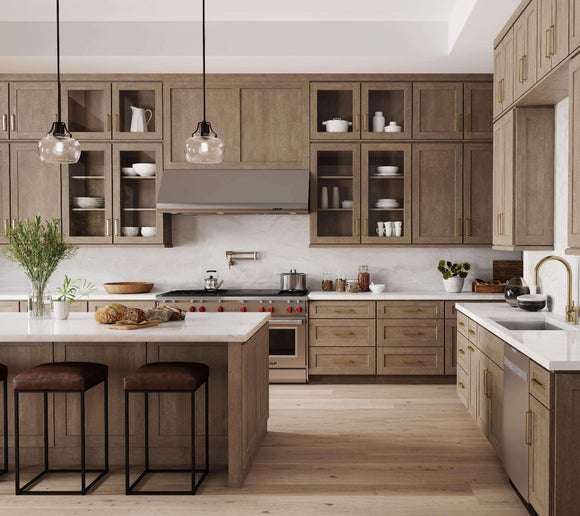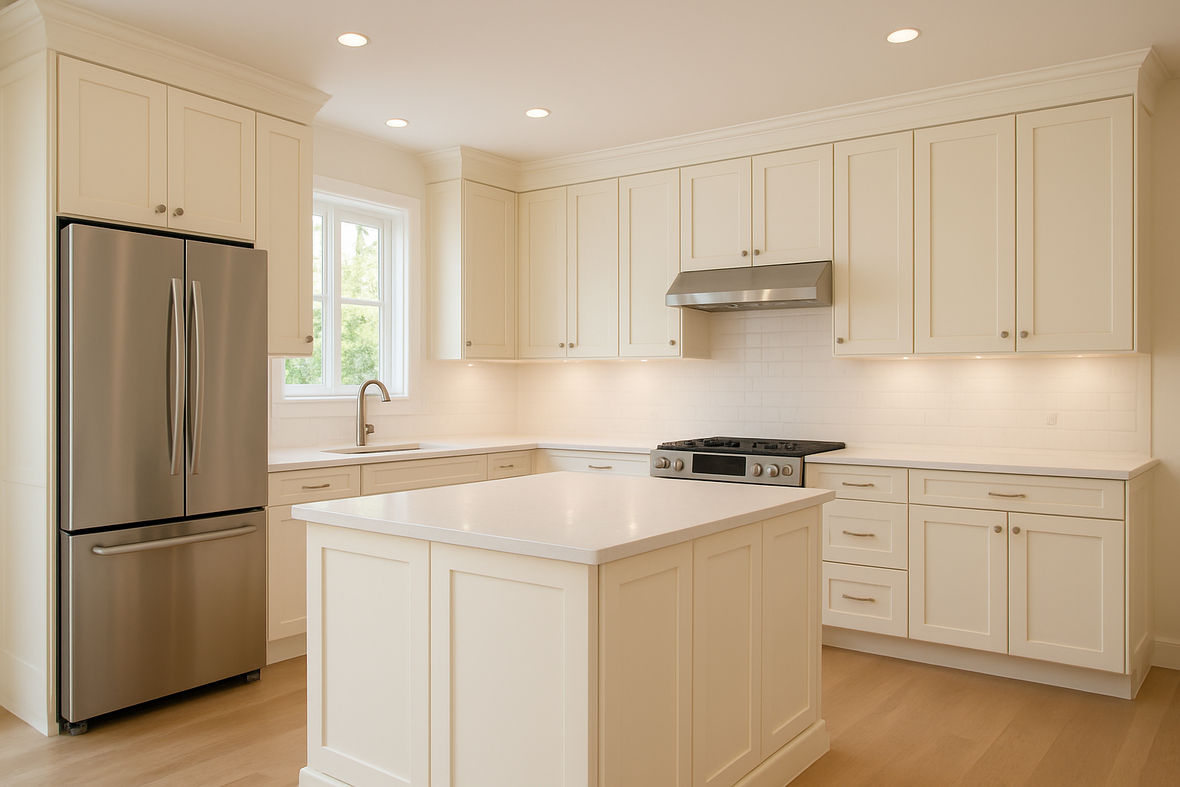
Sherwin Williams Alabaster Kitchen Cabinets: Stylish Ideas for Your Home
Alabaster Kitchen Cabinets: The Complete Guide to Sherwin Williams SW 7008
When homeowners across the country seek to transform their kitchens, many turn to alabaster white cabinets for a stunning update. This paint color has the power to completely change the space, creating a bright, lovely, and welcoming kitchen that feels twice as large. The secret behind this transformation is a single paint color that has captured the attention of designers and homeowners alike: sherwin williams alabaster. People love how versatile and timeless Alabaster is, making it a popular choice for many home improvement projects.
This warm white paint color has become the go-to choice for kitchen cabinet makeovers, offering the perfect balance between stark pure white and cream. Alabaster is considered a good paint color for kitchen cabinets because it provides warmth without yellowing and works well in a variety of lighting conditions. With an impressive Light Reflectance Value (LRV) of 82, alabaster cabinets reflect substantial light while maintaining the soft, inviting warmth that makes kitchens feel like the heart of the home.
Whether you’re planning a complete kitchen remodel or simply want to give your existing wood cabinets a fresh coat of paint, this comprehensive guide will walk you through everything you need to know about choosing, applying, and styling alabaster kitchen cabinets. Alabaster truly stands out from the rest of the paint color options due to its unique blend of warmth and brightness. The idea of using Alabaster in your kitchen design can help you achieve a cohesive and inviting space.
What Are Alabaster Kitchen Cabinets?
Alabaster kitchen cabinets feature cabinetry painted in Sherwin Williams alabaster (SW 7008), a sophisticated warm white that has become a staple in modern kitchen design. This isn’t just any white paint color – it’s a carefully formulated off white shade that strikes the perfect balance between brightness and warmth, making it a versatile choice for cabinets, walls, and even exteriors.
The magic of sw alabaster lies in its technical specifications. With an LRV of 82, this paint color reflects a significant amount of light, making kitchens feel brighter and more open without the harsh glare that can come from ultra-bright whites. The subtle yellow undertones prevent the stark, cold appearance that many people associate with pure white cabinets, creating instead a creamy, welcoming atmosphere.
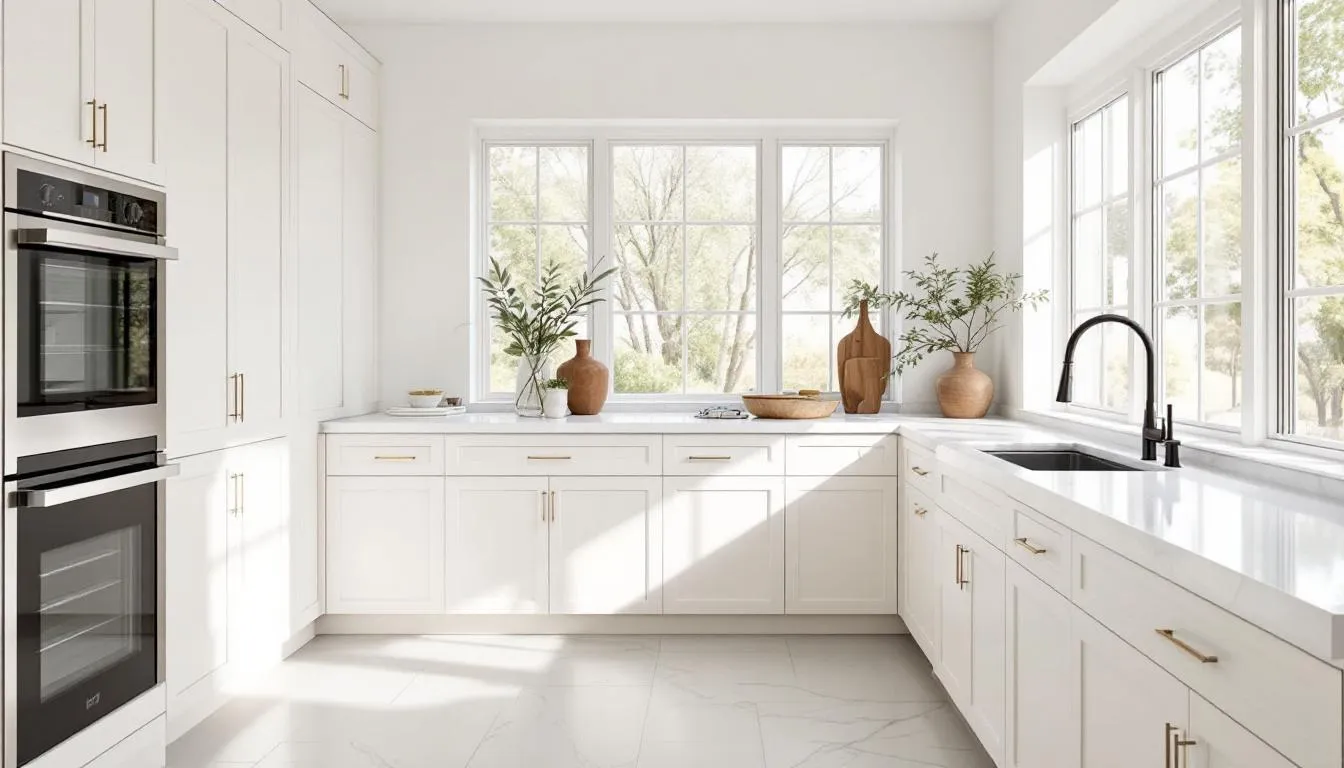
For homeowners dealing with dated wood finishes, alabaster offers the perfect solution. The trend of painted cabinets has gained popularity as a way to update traditional kitchens, and Alabaster is often chosen for its ability to modernize and brighten the space. This paint color can completely transform the look of existing cabinets, turning them from outdated eyesores into stunning focal points. The warm undertones work particularly well with natural wood grains, as they complement rather than fight against the organic warmth of the original material.
What sets alabaster apart from other white paint colors is its chameleon-like quality. Depending on lighting conditions, it can appear anywhere from a clean white to a soft, creamy beige. This adaptability makes it incredibly versatile for different kitchen styles and lighting situations, ensuring that your alabaster cabinets will look amazing in any moment of the day.
The popularity of this shade isn’t just a passing trend. Professional painters and designers consistently recommend sw alabaster for kitchen cabinets because it delivers consistent, beautiful results. Sherwin Williams Alabaster cabinets are especially appealing for those seeking a bright, cohesive, and timeless look in their kitchens. Unlike some whites that can appear yellow or gray under certain lighting, alabaster maintains its warm, welcoming character while providing the brightness that modern homeowners crave.
Why Choose Alabaster for Kitchen Cabinets
The decision to paint kitchen cabinets in alabaster comes with numerous advantages that make it a smart choice for any kitchen remodel. This versatile warm white complements various kitchen styles, from traditional farmhouse designs to sleek modern spaces, making it an investment that won’t look dated in future years.
One of the most compelling reasons to choose alabaster is its exceptional performance in challenging lighting conditions. Many kitchens struggle with limited natural light, particularly those with North-facing windows or galley layouts. The high light reflectance of alabaster helps bounce available light around the space, creating the illusion of brightness even in the darkest corners. This makes it an ideal choice for homeowners who want to maximize the feeling of space without undertaking major structural changes.
Cost-effectiveness represents another major advantage of choosing alabaster for your kitchen cabinets. Rather than investing in completely new cabinetry, painting existing cabinets in this timeless shade can deliver dramatic results at a fraction of the cost. Completing a cabinet painting job with high-quality paint and proper preparation requires attention to detail to achieve a professional finish. Professional cabinet painting with high-quality paint and proper preparation can extend the life of your existing cabinets while giving you the fresh, updated look you desire.
The psychological impact of alabaster cabinets shouldn’t be underestimated. The warm undertones create a welcoming atmosphere that makes the kitchen feel like a gathering place rather than just a functional workspace. Alabaster also pairs beautifully with a wide range of kitchen furniture, such as tables, chairs, and shelving, helping to create a cohesive and harmonious look throughout the space. This emotional connection to the space adds value beyond mere aesthetics, contributing to the overall enjoyment of your home.
From a practical standpoint, alabaster’s forgiving nature makes it easier to maintain than stark white alternatives. Minor scuffs and everyday wear are less noticeable on this warm white, meaning your cabinets will continue to look fresh longer. The slight cream undertones help camouflage the inevitable signs of daily use that can make pure white cabinets look dingy over time.
Alabaster vs Other White Cabinet Colors
Understanding how alabaster compares to other popular white cabinet colors helps homeowners make informed decisions about their kitchen remodel. Each white has its own personality and ideal applications, making the comparison process essential for achieving the desired look.
Sherwin williams pure white (SW 7005) represents the cooler end of the white spectrum, with an LRV of 84 that makes it slightly brighter than alabaster. While sw pure white creates a crisp, clean appearance, it lacks the warmth that makes alabaster so appealing in kitchen applications. Pure white works best in kitchens with abundant natural light and contemporary design elements, but it can feel stark in traditional or cozy kitchen settings.
Alabaster is also highly effective as a trim color. Its warm undertones allow it to pair well with a variety of wall colors, creating subtle contrast and a cohesive look in both modern and traditional spaces. Using alabaster as a trim color can soften the transition between walls and cabinetry, especially in rooms with changing lighting conditions.
Benjamin moore white dove offers a middle ground between alabaster and pure white, featuring subtle gray undertones that create a more muted appearance. While white dove is an excellent wall color, it doesn’t provide the same warm, inviting quality that makes alabaster ideal for kitchen cabinets. The gray undertones can sometimes appear cold in low-light conditions, making alabaster the better choice for cabinets that need to feel welcoming.
The comparison with sherwin williams greek villa reveals another important distinction. Greek villa leans more heavily into yellow undertones, making it appear creamier than alabaster. While this creates a cozy atmosphere, it can sometimes read as too yellow in certain lighting conditions. Alabaster’s more balanced undertone profile makes it more versatile across different lighting scenarios.
For cabinets specifically, alabaster’s advantage over stark whites like SW extra white becomes clear when considering daily functionality. Extra white’s bright, cool character can create glare on glossy cabinet finishes, making the kitchen feel harsh rather than welcoming. Alabaster’s softer light reflection creates a more comfortable environment for cooking and gathering.
|
Paint Color |
LRV |
Undertones |
Best Application |
|---|---|---|---|
|
SW Alabaster |
82 |
Warm yellow/cream |
Kitchen cabinets, versatile, trim color |
|
SW Pure White |
84 |
Cool, neutral |
Modern kitchens, trim |
|
BM White Dove |
85 |
Subtle gray |
Walls, traditional spaces |
|
SW Greek Villa |
80 |
Yellow/cream |
Cozy, traditional cabinets |
Best Color Combinations with Alabaster Kitchen Cabinets
Creating a cohesive color palette around alabaster kitchen cabinets opens up exciting design possibilities that can transform your entire kitchen. The warm undertones of this paint color make it an excellent foundation for both subtle, monochromatic schemes and bold, contrasting combinations.
Sherwin williams mindful gray walls create one of the most sophisticated pairings with alabaster cabinets. This soft, warm gray provides just enough contrast to define the cabinet profiles while maintaining a serene, cohesive atmosphere. The combination works particularly well in open-concept kitchens where the wall color flows into adjacent living spaces, such as the dining room, creating a seamless transition that feels both modern and timeless. Using Alabaster in the entryway also helps establish a unified home design, ensuring a welcoming and cohesive look from the moment you step inside.
For homeowners seeking a slightly more dramatic contrast, SW anew gray wall color offers a deeper alternative that still complements alabaster’s warm character. This pairing creates visual interest without overwhelming the space, making it perfect for larger kitchens where more contrast helps define different areas within the room.
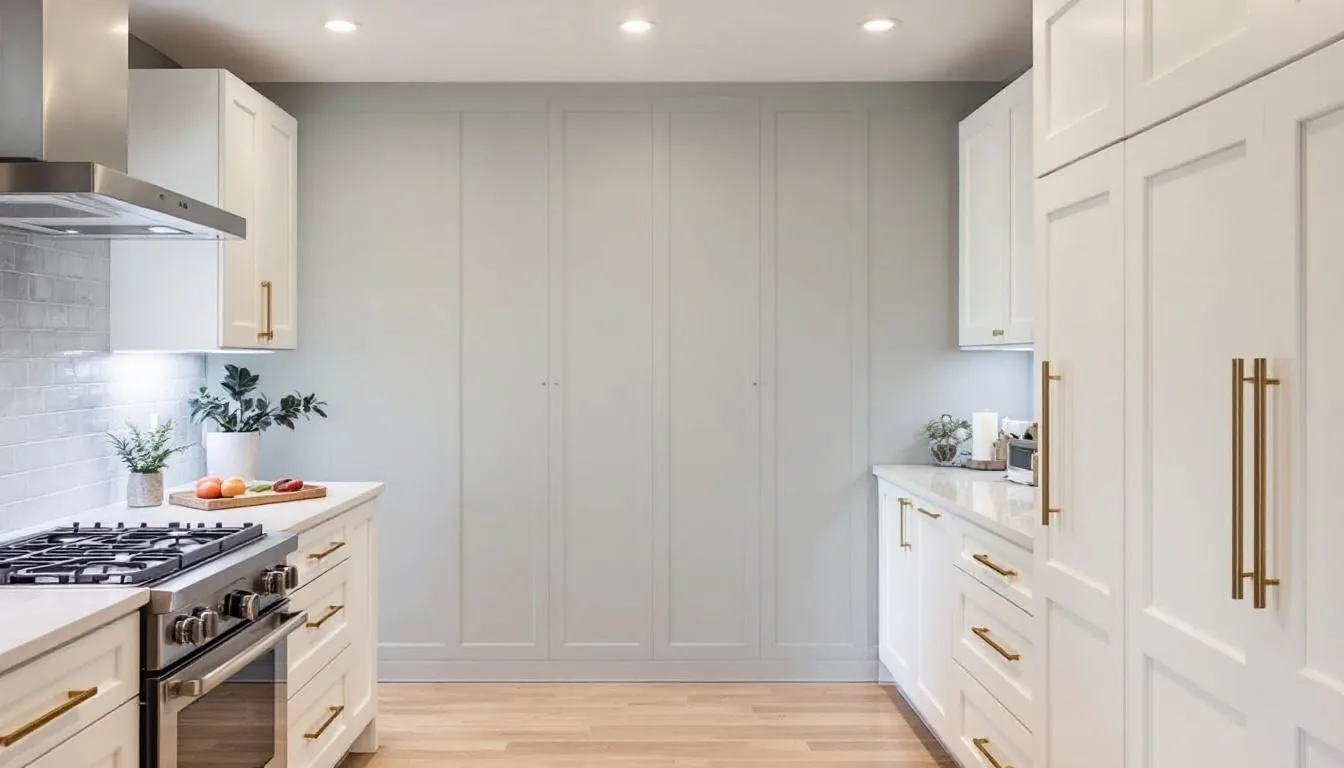
The layered white approach using sw pure white for trim and ceiling creates sophisticated depth in kitchen design. By painting alabaster cabinets, pure white trim, and keeping walls in a complementary neutral, you achieve a custom, high-end look that feels intentional rather than accidental. This technique works especially well in traditional and transitional kitchen styles where architectural details deserve highlighting.
Tuxedo kitchen designs have gained popularity for their striking visual impact, and alabaster cabinets work beautifully in these applications. Using alabaster for upper cabinets while painting lower cabinets in a contrasting color like navy blue or charcoal gray creates dynamic visual interest. The warm undertones of alabaster prevent the contrast from feeling too stark, maintaining the welcoming atmosphere that makes kitchens functional gathering spaces.
Countertop and Hardware Pairings
The success of alabaster cabinets often depends on thoughtful selection of countertops and hardware that complement rather than compete with the warm white finish. Understanding which materials enhance alabaster’s natural beauty helps create a cohesive, polished kitchen design.
Granite countertops work exceptionally well with alabaster cabinets because of their natural variation and warm undertones. Unlike some quartz surfaces that can appear too uniform against painted cabinets, granite’s organic patterns and warm veining complement alabaster’s subtle character. Popular granite choices include options with cream, beige, or warm gray veining that echo the cabinet color’s undertones.
Quartzite represents another excellent option for alabaster cabinets, offering the durability of engineered stone with the natural beauty of stone. The subtle movement in quartzite surfaces provides visual interest without competing with the cabinet color, while the material’s inherent warmth harmonizes beautifully with alabaster’s creamy undertones.
Hardware selection can make or break the overall design impact of alabaster cabinets. Brass and warm metal finishes enhance the yellow undertones naturally present in the paint color, creating a cohesive, intentional look. These warm metals add richness and depth to the overall design while maintaining the welcoming atmosphere that makes alabaster so appealing.
Black hardware creates a classic contrast that works across multiple design styles, from traditional to contemporary. The high contrast between black hardware and alabaster cabinets creates definition and visual interest while remaining timeless enough to endure changing trends. This combination works particularly well in farmhouse and transitional kitchen designs.
|
Hardware Finish |
Effect with Alabaster |
Best Style |
|---|---|---|
|
Brass/Warm Gold |
Enhances warm undertones |
Traditional, Transitional |
|
Black |
Classic contrast |
Farmhouse, Modern |
|
Brushed Nickel |
Neutral complement |
Contemporary |
|
Oil-Rubbed Bronze |
Rich, warm contrast |
Traditional, Rustic |
Alabaster in Different Kitchen Lighting Conditions
Understanding how alabaster performs under various lighting conditions helps homeowners set realistic expectations and plan their kitchen lighting accordingly. This paint color’s chameleon-like quality means its appearance can shift throughout the day and under different artificial lighting scenarios.
Natural light brings out the best in alabaster cabinets, revealing the subtle warmth and depth that make this color so appealing. In morning light, alabaster tends to appear fresh and clean, with the yellow undertones providing just enough warmth to feel welcoming. As the day progresses and light becomes more intense, the cabinets may appear slightly brighter and more neutral.
Kitchens with limited natural light present unique challenges, but alabaster’s high LRV of 82 helps maximize whatever light is available. In North-facing kitchens that receive cooler, indirect light throughout most of the day, alabaster maintains its warm character better than cooler whites that might appear gray or dingy under these conditions.
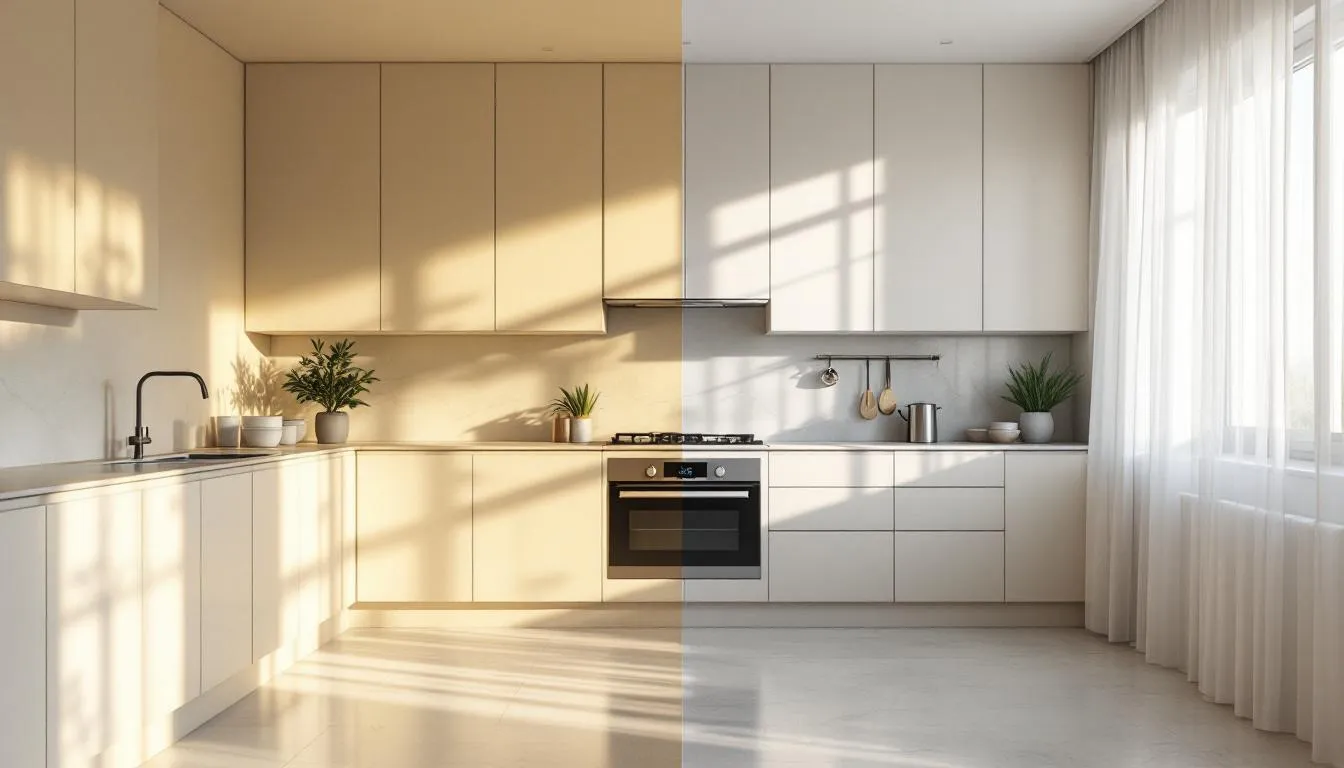
Artificial lighting choices significantly impact how alabaster appears in the evening hours when kitchens see heavy use. Warm LED lighting (2700K-3000K) enhances the creamy undertones, creating a cozy atmosphere perfect for family dinners and entertaining. Cooler LED lighting (4000K-5000K) can make alabaster appear more neutral, which some homeowners prefer for task-oriented kitchen work.
Under-cabinet lighting provides both functional and aesthetic benefits when paired with alabaster cabinets. LED strip lights create even illumination for food preparation while highlighting the cabinet color’s warm undertones. This layered lighting approach helps maintain consistent color appearance regardless of time of day or weather conditions.
Open-concept kitchen designs benefit particularly from alabaster’s consistent performance across different lighting zones. As natural light flows from windows through the kitchen and into adjacent living spaces, alabaster cabinets maintain their character without appearing dramatically different from room to room.
Alabaster's performance in varying lighting conditions also makes it a popular choice for the bathroom, where it creates a warm, spa-like atmosphere.
Design Styles That Work with Alabaster Kitchen Cabinets
The versatility of alabaster kitchen cabinets allows them to work beautifully across multiple design styles, making them a smart choice for homeowners who appreciate flexibility in their decorating approach. Understanding how to style alabaster cabinets for different aesthetic preferences helps create cohesive, intentional kitchen designs.
Farmhouse kitchen designs represent one of the most natural applications for alabaster cabinets. Paired with shaker-style cabinet doors and subway tile backsplashes, alabaster creates the clean, fresh atmosphere that defines modern farmhouse style. The warm undertones complement natural wood elements like butcher block countertops and open shelving, while the brightness keeps the space from feeling too rustic or heavy.
Modern transitional kitchens benefit from alabaster’s ability to bridge traditional warmth with contemporary clean lines. In these applications, alabaster cabinets work well with quartz countertops in neutral tones and sleek hardware in brushed nickel or matte black. The color provides enough warmth to keep the space from feeling cold while maintaining the sophistication that defines transitional design.
Traditional kitchen designs find new life with alabaster cabinets, particularly when updating older homes with classic architectural details. The warm white color respects the home’s historical character while providing the brightness that modern families expect. Paired with traditional hardware in brass or oil-rubbed bronze, alabaster cabinets can make an older kitchen feel fresh without losing its authentic character. If you’re planning to update your kitchen, making a purchase of Sherwin Williams Alabaster paint or related materials is a great way to achieve this timeless look.
Contemporary kitchen designs use alabaster as a neutral foundation that allows other elements to take center stage. In these minimalist applications, the color provides warmth without visual weight, creating a serene backdrop for statement pieces like colorful backsplashes or dramatic light fixtures. The high light reflectance contributes to the clean, uncluttered aesthetic that defines contemporary design.
Cottage and coastal kitchen styles embrace alabaster’s soft, welcoming character. The color works beautifully with beadboard details, glass-front cabinets, and coastal-inspired hardware. The warm undertones complement the relaxed, comfortable atmosphere that defines these styles while providing enough brightness to evoke the airy feeling of beachside living.
For more inspiration, check out our post showcasing various design styles with Alabaster cabinets to see how this versatile color can transform your kitchen, or explore blue gray cabinets like JSI's Amesbury Mist for a fresh, modern look.
Kitchen Cabinet Options with Alabaster
Sherwin Williams Alabaster is a favorite for kitchen cabinets because of its ability to adapt to a wide range of kitchen styles and design ideas. Whether you’re dreaming of a modern, all-white kitchen or a more traditional space with warm accents, alabaster cabinets provide a soft, inviting foundation. For a classic white kitchen, pair alabaster cabinets with white subway tile and white grout—this combination creates a seamless, clean look that feels both timeless and fresh. If you prefer a warmer, more traditional atmosphere, consider combining alabaster cabinets with rich wood floors and granite countertops. The subtle warmth of this white paint color beautifully complements the natural tones in granite, making your kitchen feel cozy yet sophisticated.
Alabaster cabinets also work well in transitional kitchens, where you might blend modern appliances with classic design elements. For example, pairing alabaster cabinets with GE Monogram appliances and sleek hardware can give your kitchen a fresh, elegant look that’s both functional and stylish. The versatility of sherwin williams alabaster means it can serve as a neutral backdrop, allowing your countertops, backsplash, and decor to shine. Whether you’re planning a full kitchen remodel or simply updating your kitchen cabinets with a new paint color, alabaster is a great option for creating a soft, welcoming space that feels brighter and more open. Its warm white undertones ensure your kitchen never feels stark, making it a popular choice among homeowners looking for both beauty and practicality.
Trim and Ceiling Colors to Pair with Alabaster Cabinets
Choosing the right trim and ceiling colors is key to enhancing the beauty of your alabaster cabinets and creating a harmonious kitchen space. One of the most popular options is Sherwin Williams Pure White (SW 7005) for trim and ceilings. Pure White offers a crisp, clean contrast to the warm undertones of alabaster, helping to define architectural details and add a touch of brightness without feeling cold. For a polished look, use a semi gloss finish on the trim—this not only adds subtle shine but also makes cleaning easier in high-traffic kitchen areas. Pair this with a flat finish on the ceiling to create visual depth and keep the focus on your beautiful cabinets and countertops.
If you prefer a more unified look, consider painting the trim and ceiling in alabaster as well. This monochromatic approach can make your kitchen feel larger and more cohesive, especially when paired with warm materials like granite or quartz countertops. Alternatively, warm white trim colors such as Sherwin Williams ProClassic White (SW 6251) can complement alabaster cabinets, adding a gentle warmth that ties the whole space together. The key is to balance the warmth of your cabinets with the surrounding trim and ceiling colors, ensuring your kitchen feels inviting and well-coordinated. Whether you opt for contrast or cohesion, thoughtful color choices will highlight your alabaster cabinets and create a kitchen that feels both fresh and timeless.
Sampling and Testing Alabaster for Your Kitchen
Before you commit to painting your kitchen cabinets in Sherwin Williams Alabaster, it’s essential to sample and test the color in your own space. Lighting, wall color, countertops, and even the direction your kitchen faces can all influence how alabaster appears throughout the day. Start by using peel-and-stick paint samples or painting a small section of your cabinets to see how the color interacts with your existing finishes and lighting. Pay attention to how alabaster looks next to your countertops, backsplash, and walls—this will help you determine if the warm white undertones are the right fit for your kitchen remodel.
Take the time to observe the color at different times of day, as natural and artificial lighting can change the appearance of alabaster cabinets. Look for inspiration in photos and videos of kitchens that feature sherwin williams alabaster, and notice how the color pairs with various design elements and materials. If you’re unsure, consult with a professional painter or designer who can offer guidance based on your specific kitchen layout and style. Sampling and testing before painting ensures you’ll love the final result, saving you time, money, and the hassle of repainting. With a little preparation, you can confidently choose alabaster cabinets that will brighten your kitchen and create a welcoming, beautiful space.
Common Mistakes to Avoid with Alabaster Kitchen Cabinets
Learning from others’ mistakes can save time, money, and frustration when painting kitchen cabinets in alabaster. Understanding common pitfalls helps ensure your project delivers the beautiful results you envision.
Skipping proper surface preparation represents the most frequent mistake that leads to disappointing outcomes. Some homeowners, eager to see quick results, attempt to paint over existing finishes without adequate cleaning, sanding, or priming. This shortcut inevitably leads to poor paint adhesion, resulting in chipping, peeling, or an uneven finish that requires complete removal and restart of the process.
Using incorrect primer creates another common problem, particularly when painting oak cabinets or other woods prone to tannin bleed-through. Generic primers may not adequately seal wood tannins, causing yellow or brown stains to appear through the alabaster paint over time. Investing in high-quality bonding primer specifically designed for cabinets prevents this costly mistake.
Choosing the wrong paint sheen affects both appearance and durability. While flat or eggshell paints might seem appealing for their smooth appearance, they lack the durability needed for kitchen cabinet applications. Semi gloss provides the best balance of durability and appearance, offering easy cleaning and resistance to moisture and grease.
Testing mistakes cost homeowners significant time and money. Failing to test alabaster in your specific kitchen lighting before committing to the entire project can lead to unpleasant surprises. Traditional paint testing methods, like painting large poster boards, can create a mess and add unnecessary cleanup. Modern alternatives, such as peel-and-stick samples, help you avoid this mess and make testing easier. What looks perfect on a small sample card may appear different when applied to large cabinet surfaces under your kitchen’s unique lighting conditions.
Attempting to match alabaster across different paint brands creates consistency problems. Some homeowners assume all “alabaster” colors are identical, but subtle differences between manufacturers can create noticeable variations in the final result. Stick with sherwin williams sw alabaster throughout the project for consistent results.
Rushing the painting process undermines all preparation efforts. Each coat requires adequate drying time, and attempting to speed the process by applying subsequent coats too quickly leads to poor adhesion, brush marks, and an overall unprofessional appearance.
Maintenance and Care for Alabaster Kitchen Cabinets
Proper maintenance ensures that your alabaster kitchen cabinets continue to look fresh and beautiful for years to come. Understanding the specific needs of this warm white paint color helps preserve its appearance and extend the life of your investment.
Regular cleaning represents the most important aspect of maintaining alabaster cabinets. Use a mild soap solution and microfiber cloth to remove cooking grease and everyday grime without damaging the paint finish. Avoid abrasive cleaners or scrubbing pads that can dull the semi gloss finish and create areas where dirt can accumulate.
Touch-up techniques help address minor scratches and wear spots before they become major problems. Keep leftover paint for touch-ups, storing it properly to maintain its quality. Small scratches can often be addressed with careful application using a small artist’s brush, while larger areas may require light sanding and re-coating.
Preventing yellowing and discoloration requires attention to environmental factors. Excessive heat from cooking can cause paint to yellow over time, particularly around stovetop areas. Ensure adequate ventilation during cooking and consider using range hoods to minimize heat and grease exposure to cabinet surfaces.
The expected lifespan of properly painted alabaster kitchen cabinets ranges from 8-12 years under normal use conditions. Factors affecting longevity include quality of initial preparation, paint quality, environmental conditions, and maintenance practices. High-traffic areas around dishwashers and frequently used cabinet doors may show wear sooner than other areas.
Knowing when to consider repainting helps maintain the fresh appearance that makes alabaster cabinets so appealing. Signs that indicate time for repainting include widespread scratching, dullness that doesn’t respond to cleaning, visible wear at high-touch points, and color shifts that make the cabinets appear dingy compared to trim or walls.
Preventive measures extend cabinet life significantly. Use soft-close hardware to reduce impact wear, install bumpers on frequently closed doors, and address spills immediately to prevent staining. These simple steps help preserve the beauty of your alabaster cabinets and delay the need for major refinishing.
Professional maintenance services can be cost-effective for homeowners who want to maximize their cabinet investment. Many cabinet painters offer maintenance programs that include periodic cleaning, touch-ups, and assessment of overall condition. This professional attention can significantly extend the life of your painted cabinets while maintaining their like-new appearance.
Conclusion
Alabaster kitchen cabinets offer an exceptional combination of warmth, brightness, and versatility that makes them an outstanding choice for any kitchen remodel. Whether you’re transforming dated oak cabinets or planning a complete kitchen renovation, sherwin williams alabaster provides the perfect foundation for creating a space that feels both timeless and thoroughly modern.
The comprehensive benefits of this remarkable paint color – from its ideal LRV of 82 that brightens spaces without glare, to its warm undertones that create welcoming atmospheres – position alabaster as more than just a trend. It’s a thoughtful design choice that delivers lasting beauty and exceptional value.
With proper preparation, quality materials, and attention to detail, your alabaster cabinet project can transform your kitchen into the bright, welcoming space you’ve always envisioned. The investment in time and effort pays dividends in both daily enjoyment and long-term home value, making alabaster kitchen cabinets a decision you’ll appreciate for years to come.



